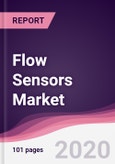What is Flow sensor?
Flow sensors are devices which are used to measure the rate of fluid flow either directly or inferentially. Direct measurement involves the measurement of the volumetric flow rate of the fluid. Inferential flow measurement involves estimation of the flow rate by measuring other fluid parameters such as pressure, temperature, mass etc.
Types of flow sensor:-
Turbine flow sensor:
The turbine flow sensor is a type of flow sensor used for flow measurement or dosing applications for liquids. It has an integral LCD display which indicates the flow rate & total consumption of fluid pass through the flow meter.
Electromagnetic Flow Sensor:
Electromagnetic flow sensors are the type of flow sensors which detect flow by using Faraday's Law of induction. There is an electromagnetic coil inside an electromagnetic flow meter, that generates a magnetic field, and electrodes that capture electromotive force (voltage). However it appears to be there is nothing inside the flow pipe of an electromagnetic flow meter, flow can be measured.
The electromagnetic flow meter is a volumetric flow meter having no obstruction as there are no moving parts. Hence pressure drop is negligible. Its performance is independent of density, viscosity, temperature and pressure of the flowing liquid.
Thermal Mass Flow Sensor:
Thermal mass flow sensors use the thermal properties of the fluid to measure the flow of a fluid flowing in a pipe or duct. Thermal mass flow sensors also called as thermal dispersion sensor consists a family of instruments for the measurement of the total mass flow rate of a fluid flowing through closed conduits. This flow sensor is used for gases and compressed air
Market Research and Market Trends of Flow sensor Market
The Hach Company has introduced EM950 flow sensor which is designed to capture the flow velocity using electromagnetic technology and an optional pressure transducer is added to automatically capture depth readings. EM950 sensor has no moving parts, it doesn’t even require any mechanical maintenance and easily makes measurements in low velocities and in both clean and dirty water. Since it is coupled with the company’s Handheld Flow Meter, the EM950 sensor has the efficiency to depict rivers and streams, validate wastewater flow data or identify ideal metering locations for wastewater flow monitoring.
Elster Instromet, a German manufacturer has produced Turbine sensors and Quantometer sensors which display the volume flowing through the device in actual cubic meters. The incoming gas is surged through the inlet body and strikes the blades of the turbine wheel. The rotations of the turbine wheel are converted to an eight digit roller counter through a multistage gear and a magnetic coupling. The turbine sensors are authorized for official metering and billing purposes of natural gas in gas transmission and distribution as well as with a variety of technical gases in industrial applications.
Micro Motion Inc has designed the latest Coriolis flow sensor for superior precision measurement and process control for low-flow and high-capacity applications. Coriolis flow meters deliver the most accurate, repeatable mass flow measurement for liquids, gases or slurries. For essentially any process fluid, these advanced sensors offer the most precise measurement available, while exhibiting exceptionally low pressure drop. The technology is based on the principle that inertia created by the fluid flow causes the meter’s tubes to twist proportional to the mass flow rate.
A France based organization called Faure Herman, is one of the leaders of Flow sensors market. The company recently developed an Ultrasonic flow sensor called FH8400 which is used for bi-directional measurement of fluids and also removable transducers under pressure and flowing. It can be used for various applications such as pipeline leak detection, oil refineries, chemical & petro-chemical plants, oil production, energy / power plants, water & wastewater and more.
Who are the Major Players in Flow sensor market?
The companies referred to in the market research report includes Bopp & Reuther Messtechnik GmbH, Brooks Instrument, Cameron Measurement Systems: Caldon, Hach Company, Faure Herman, Elster Instromet, Micro Motion Inc, OVAL Corporation and more than 25 companies.
What is our report scope?
The report incorporates in-depth assessment of the competitive landscape, product market sizing, product benchmarking, market trends, product developments, financial analysis, strategic analysis and so on to gauge the impact forces and potential opportunities of the market. Apart from this the report also includes a study of major developments in the market such as product launches, agreements, acquisitions, collaborations, mergers and so on to comprehend the prevailing market dynamics at present and its impact during the forecast period 2018-2023.
Key Takeaways from this Report
- Evaluate market potential through analyzing growth rates (CAGR %), Volume (Units) and Value ($M) data given at country level – for product types, end use applications and by different industry verticals.
- Understand the different dynamics influencing the market – key driving factors, challenges and hidden opportunities.
- Get in-depth insights on your competitor performance – market shares, strategies, financial benchmarking, product benchmarking, SWOT and more.
- Analyze the sales and distribution channels across key geographies to improve top-line revenues.
- Understand the industry supply chain with a deep-dive on the value augmentation at each step, in order to optimize value and bring efficiencies in your processes.
- Get a quick outlook on the market entropy – M&A’s, deals, partnerships, product launches of all key players for the past 4 years.
- Evaluate the supply-demand gaps, import-export statistics and regulatory landscape for more than top 20 countries globally for the market.
Table of Contents
Methodology

LOADING...








